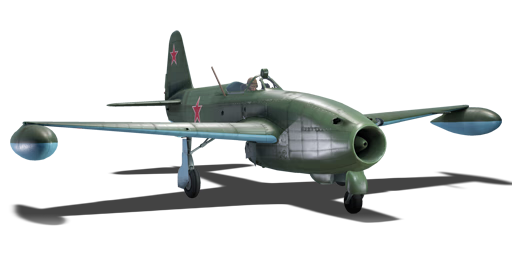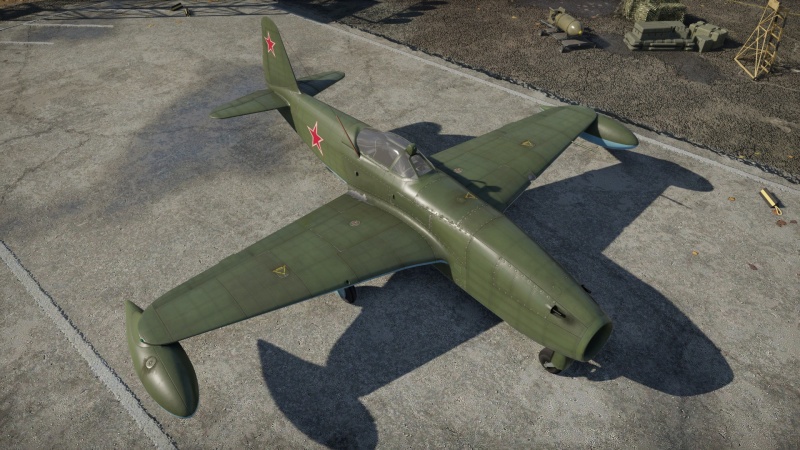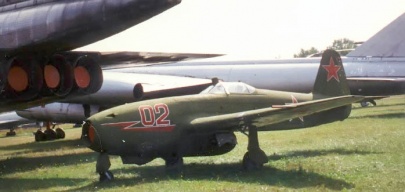Yak-17
Contents
Description
The Yak-17 was a further development of the Yak-15 jet fighter developed by the Soviet Union. The Yak-17 was also the basis for the Yak-23 and it functioned as the main training fighter for pilots transitioning from piston-engine fighters to jet engines. The Yak-17 was very similar to the Yak-15, it retained the airframe of the Yak-3 and only addressed a few issues to make the fighter more viable. It introduced a bulletproof glass pane in the front of the cockpit as well as extra fuel tanks for longer range. The biggest improvement was the introduction of a modern landing gear like the one present in the MiG-9. Only 430 units were made and most of them were eventually given to the Czech and Polish air forces.
It was introduced in Update 1.33. Similar to its hybrid predecessors, the Yak-17 is arguably one of the most underestimated aircraft in the game. Although its stat card reveals what would be considered "sub-par" performance and armament, the Yak-17 is both a unique and deadly fighter. Unlike its propeller-driven counterparts, this first generation jet aircraft wields the ability to hold on to energy in a straight line, whereas prop aircraft will slowly lose speed. This, coupled with its good rate of turn, allows the Yak-17 to defend itself against both propeller and jet-powered aircraft, which is what it will normally face in all game modes. The Yak 17 biggest issues are the low top speed and the poor acceleration caused by a weak engine. The aircraft also includes very small improvements over the Yak-15 and plays largely the same, that is, forcing piston fighters into energy fights and avoiding prolonged fights with more modern jet fighters like the F-80C and F2H Banshee.
General info
Flight performance
The Yak-17 has a very weak engine, the Junkers Jumo 004. This engine gives the Yak-17 poor acceleration, mediocre climb rate and a relatively low top speed compared to other jet fighters at its BR. However, it's enough to allow it to hold energy better than most piston engine fighters.
| Characteristics | Max Speed (km/h at 4,000 m) |
Max altitude (metres) |
Turn time (seconds) |
Rate of climb (metres/second) |
Take-off run (metres) | |||
|---|---|---|---|---|---|---|---|---|
| AB | RB | AB | RB | AB | RB | |||
| Stock | 720 | 700 | 19.3 | 20.2 | 19.9 | 19.4 | 366 | |
| Upgraded | 792 | 755 | 18.3 | 18.5 | 26.5 | 23.0 | ||
Details
| Features | |||||
|---|---|---|---|---|---|
| Combat flaps | Take-off flaps | Landing flaps | Air brakes | Arrestor gear | Drogue chute |
| X | X | ✓ | X | X | X |
| Limits | ||||||
|---|---|---|---|---|---|---|
| Wings (km/h) | Gear (km/h) | Flaps (km/h) | Max Static G | |||
| Combat | Take-off | Landing | + | - | ||
| 765 | N/A | N/A | 320 | ~11 | ~8 | |
| Optimal velocities (km/h) | |||
|---|---|---|---|
| Ailerons | Rudder | Elevators | Radiator |
| < 380 | < 420 | < 500 | N/A |
Engine performance
| Engine | Aircraft mass | ||||||
|---|---|---|---|---|---|---|---|
| Engine name | Number | Basic mass | Wing loading (full fuel) | ||||
| Klimov RD-10 | 1 | 2,191 kg | 190 kg/m2 | ||||
| Engine characteristics | Mass with fuel (no weapons load) | Max Gross Weight | |||||
| Weight (each) | Type | 10m fuel | 20m fuel | 30m fuel | 34m fuel | ||
| 760 kg | Axial-flow turbojet | 2,378 kg | 2,554 kg | 2,738 kg | 2,815 kg | 2,835 kg | |
| Maximum engine thrust @ 0 m (RB/SB) | Thrust to weight ratio @ 0 m (100%) | ||||||
| Condition | 100% | WEP | 10m fuel | 20m fuel | 30m fuel | 34m fuel | MGW |
| Stationary | 910 kgf | N/A | 0.38 | 0.36 | 0.33 | 0.32 | 0.32 |
| Optimal | 910 kgf (0 km/h) |
N/A | 0.38 | 0.36 | 0.33 | 0.32 | 0.32 |
Survivability and armour
- 55 mm Bulletproof glass in cockpit front.
- 8.5 mm Steel plate in pilot's seat.
Modifications and economy
Obtaining the "Offensive 23 mm" modification is the best choice for your first module, as it allows for more flexibility in armament. Next, try to obtain the "compressor" and "engine" upgrades, as they both increase engine thrust which is essential in escaping from a dogfight turned sour. Finally, obtain the rest of the performance upgrades as they will all collectively increase top speed, turn time, and rate of climb.
Armaments
Offensive armament
The Yak-17 is armed with:
- 2 x 23 mm NS-23 cannons, nose-mounted (60 rpg = 120 total)
Usage in battles
Arcade Battles
In Arcade battles, the Yak-17 is capable of breaking up a "furball" due to its impressive turn time. This, coupled with its hard-hitting cannons, makes any Yak-17 pilot an indispensable asset to any arcade team.
Realistic Battles
In Realistic battles, climbing with this aircraft at the start of a match is not always the best course of action, considering how poor the Yak-17's rate of climb is. Instead of the traditional slow angled climb, the Yak-17 is best used in a "zoom climb", where once enough energy has been built up at a low altitude, the Yak-17 pilot will quickly pitch up, thus gaining a lot of altitude quickly. This way, if attacked during the first few minutes of the match, the Yak-17 still wields some energy, whereas had the Yak-17 been slowly climbing, it would have had to face another aircraft's guns.
In order to shake an enemy, especially one that is propeller driven, dive low to the ground to ensure your assailant's speed only decreases. This is called a "speed trap", and can either be followed by a "hammerhead" attack or a continuation of the escape. This tactic of utilizing the Yak-17's ability to hold on to energy in a straight line is negated when facing other jet aircraft who wield the same ability. This is where the Yak-17's dogfighting abilities come into play. Because it is so similar to the Yak-3 and the previous Yakovlev jets, the Yak-17 retains some of their manoeuvrability characteristics, namely their turn times. This facet often proves an indispensable one, as other first generation jets will not be able to maintain a tight enough turn circle.
General Usage
Like its predecessors, the Yak-17 is severely hampered in its damage output due to its reliance on a single set of 23 mm NS-23 cannons, with 120 shells total. It is possible to expend this pool in seconds. The Yak-17 shares this downfall with aircraft like the Ki-200 and the Me 163. Firing in small, accurate bursts negates this problem, and is the most efficient way of destroying enemies. The 23 mm shells these cannons fire are extremely deadly when they hit, often ripping enemies apart on impact.
To use the cannons most effectively, only fire when you are close to your target. The reason for this is twofold: First, the limited ammo means you want your shots to count. Being close to your target will give your cannons the highest chance of hitting. The second reason is because of the ballistics of the 23 mm shells - their muzzle velocity is not very high, meaning you have to lead your targets by quite a bit. If you are closer to your target, you won't have to lead them by quite as much, though it will still have to be more than other cannons.
With some practice, it is possible to consistently get 3 fighter kills with one load of ammunition in realistic battles. Using the Air Targets belt is the most effective. However, attacking bombers is best left to other planes with more firepower, since the Yak-17 does not have the firepower or ammunition to reliably kill heavy bombers without sustaining heavy damage. Heavy fighters such as the F7F-1 may also take longer to destroy than other fighters.
Pros and cons
Pros:
- Excellent turn time for a jet fighter
- Good armament
- Very good roll rate
- Fairly responsive at higher speeds
Cons:
- Slow compared to other jet fighters in BR
- Low ammunition count
- Poor rate of climb
- Poor acceleration
- Minimal armour protection
- Inability to carry a payload
History
The Yak-17 was a further development of the Yak-15, which was the first Soviet jet fighter alongside the MiG-9. The Yak-17 could be considered a series of upgrades that could be applied to the Yak-15 and make the jet more viable for longer term use.
The Yak-17 saw most of its life as a trainer rather than as a true jet fighter. This is because it used the airframe of the Yak-3, which was a fighter very familiar to all Soviet pilots, and thus, it was easier for them to transition from piston fighters to jet engines in an already familiar platform like the Yak-3 but using a jet engine.
The Yak-17 received a handful of upgrades compared to the Yak-15, a bulletproof glass in front of the cockpit for better pilot protection, and mirrors to increase visibility during dogfights. It also added external fuel tanks under the wings that could be jettisoned to avoid loss of performance. However, the most important upgrade was the installation of a modern landing gear like the one in the MiG-9. This was extremely necessary if the Yak-17 was going to be used to train old pilots and adapt them into jet engine fighters.
Two versions of this aircraft were made, with a total of 430 units built. These versions were the normal Yak-17 and the Yak-17UTI that was a trainer version with two seats and duplicated controls. The Yak-17 was the main trainer of the Soviet Union during the early 1950s. The Yak-17 was mainly given to the Polish and Czech air force.
Media
- Skins
- Videos
See also
Links to the articles on the War Thunder Wiki that you think will be useful for the reader, for example:
- reference to the series of the aircraft;
- links to approximate analogues of other nations and research trees.
External links
| A.S. Yakovlev Design Bureau (Яковлев Опытное конструкторское бюро) | |
|---|---|
| Fighters | |
| Yak-1 | Yak-1 · Yak-1B |
| Yak-3 | Yak-3 · Eremin's Yak-3(e) · Yak-3 (VK-107) · Yak-3P · Yak-3T · Yak-3U |
| Yak-7 | Yak-7B |
| Yak-9 | Yak-9 · Yak-9B · Yak-9K · Golovachev's Yak-9M · Yak-9P · Yak-9T · Yak-9U · Yak-9UT |
| Twin-engine fighters | I-29 |
| Jet fighters | |
| Yak-15 | Yak-15P · Yak-15 |
| Yak-17 | Yak-17 |
| Yak-23 | Yak-23 |
| Yak-30 | Yak-30D |
| Yak-141 | Yak-141 |
| Strike aircraft | |
| Yak-2 | Yak-2 KABB |
| Yak-38 | Yak-38 · Yak-38M |
| Bombers | Yak-4 |
| Jet bombers | Yak-28B |
| Foreign use | ▄Yak-3 · Challe's ▄Yak-9T · ◔Yak-9P |
| Captured | ▀Yak-1B |
| USSR jet aircraft | |
|---|---|
| Bereznyak-Isayev | BI |
| Yakovlev | Yak-15 · Yak-15P · Yak-17 · Yak-23 · Yak-28B · Yak-30D · Yak-38 · Yak-38M · Yak-141 |
| Mikoyan-Gurevich | MiG-9 · MiG-9 (l) · MiG-15 · MiG-15bis · MiG-15bis ISh · MiG-17 · MiG-17AS · MiG-19PT |
| MiG-21F-13 · MiG-21PFM · MiG-21S (R-13-300) · MiG-21SMT · MiG-21bis | |
| MiG-23M · MiG-23ML · MiG-23MLD · MiG-27M · MiG-27K | |
| MiG-29 · MiG-29SMT | |
| Lavochkin | La-174 · La-15 · La-200 |
| Sukhoi | Su-9 · Su-11 |
| Su-7B · Su-7BKL · Su-7BMK · Su-17M2 · Su-17M4 · Su-22M3 | |
| Su-24M | |
| Su-25 · Su-25BM · Su-25K · Su-25T · Su-25SM3 · Su-39 | |
| Su-27 · Su-27SM | |
| Su-34 | |
| Ilyushin | IL-28 · IL-28Sh |
| Tupolev | Tu-14T |






